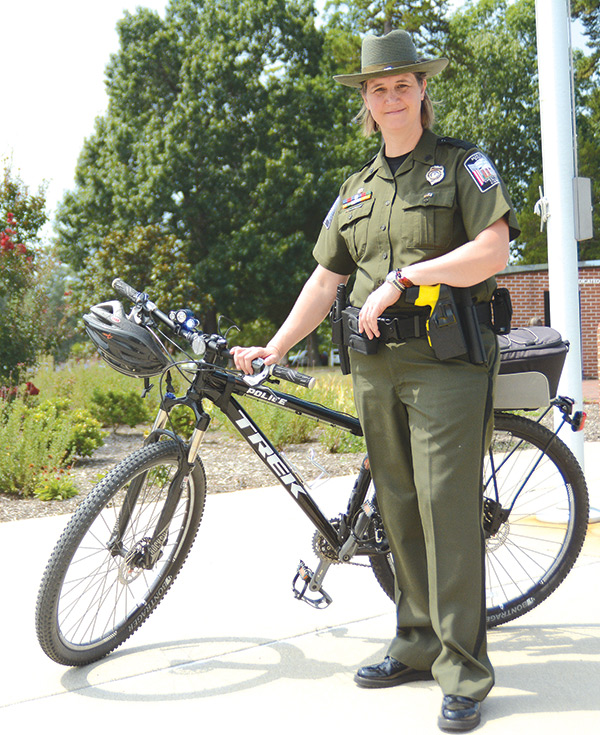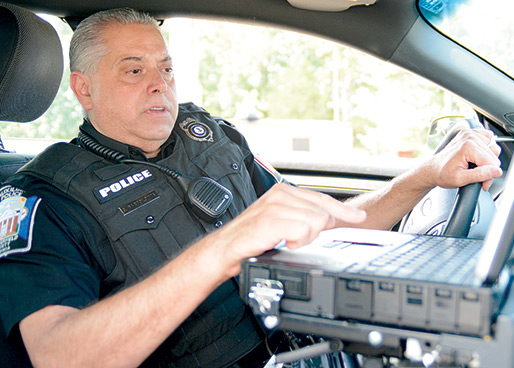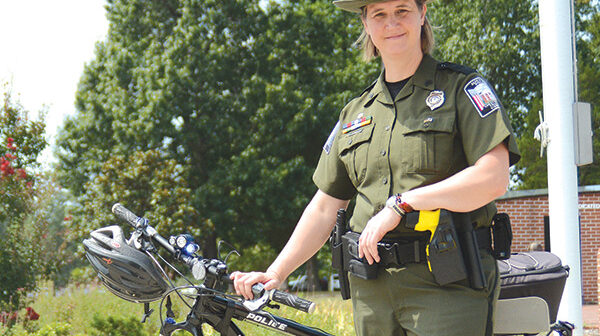
Tracy Connor might be seen working on a bike once a month for the Chesterfield County Police Department. (Caleb M. Soptelean photos) 
Gerard Bartolotta uses a Panasonic Toughbook, a police mobile data center, while on patrol.
It takes a lot of dedication to be an auxiliary police officer.
The position is unpaid and involves carrying a firearm and a Taser.
Many people may not have the time or the desire for such a part-time job, but those that do enjoy it.
Tracy Connor, 43, works for Chesterfield County Police Training Academy as a trainer in her “day job.” She is married but has no kids or grandkids. This allows her to volunteer 15 hours a week as an auxiliary officer.
“I want to serve my community,” she said. “I always wanted to do police work.”
Connor, who emigrated from England 20 years ago or so, has been an auxiliary police officer for six and a half years.
One of 17 such officers, she works as a driving instructor for police academy recruits, and also as a NARCAN anti-narcotic instructor and on bicycle patrol.
Connor is so dedicated to the part-time job, she either works 15 hours a week after her regular job during the week or on weekends.
“We are fully-sworn law enforcement officers,” she said, noting that auxiliary officers make arrests and respond to calls just like paid officers.
Although they’re not paid, auxiliary officers are eligible for workman’s compensation.
New York native
Gerard Bartolotta, 58, grew up in upstate New York and relocated to central Virginia 30 years ago. He worked for the Richmond Police Department for 12 1/2 years and retired five years ago. At that time, he started a kitchen remodeling business – Brite Kitchen Refacing – but wanted to continue to give back.
The Short Pump resident noted that Henrico County does not have auxiliary police, and although Hanover County does, he came to Chesterfield because it has more opportunities.
“It’s the most rewarding thing I can do for my community,” he said.
Bartolotta works two 8-hour shifts a month, basically every other weekend.
He provides traffic enforcement on “speed patrol,” but also does “seasonal safety patrol,” which involves patrolling shopping malls and parking lots, especially between Black Friday and New Year’s Day. This can involve stopping fights and responding to shoplifting, larcenies and robberies, for example.
Auxiliary officers support paid officers at special events, such as the county fair and the July 4 event, and “directed patrol” events, which cover areas that have been hit especially hard with certain crimes.
Other auxiliary officers help with marine patrol, SWAT team and in hostage negotiations.
Officers are expected to help with each of the Chesterfield County Police Department’s four zones, including Midlothian, Hull Street/Woodlake, Chester (on Route 10 next to Chick-fil-A) and Central, the latter on Public Safety Way in the county government complex.
Recruitment for auxiliary police officers is “very difficult,” Bartolotta said. This is because it requires nearly 1,000 hours of training within 11 1/2 months at the Chesterfield Police Academy, followed by 100 hours of field training. Once the training is complete, auxiliary officers must work 250 hours a year, or about 21 a month.
“When citizens see us, they think we’re paid officers,” Bartolotta said.
The only noticeable difference is an auxiliary officer wears a different patch on the upper right arm and badge on the chest.
Those who have a desire to help – but don’t want to make as much of a commitment and not carry a firearm – can become motorist assist officers.
This could involve directing traffic at intersections and responding to calls about disabled vehicles. Motorist assist officers go through about 40 hours of training, Connor said.


